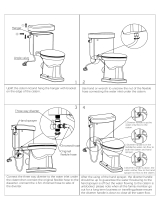With specific exceptions, the installing of any type of AGA
Cooker is subject to the respective directions contained in
current issue of The Building Regulations. In addition,
Planning Permission may need to be obtained, which
should be applied for separately. The complete range of
AGA cookers are suitable for Natural or Propane gases
only and cannot be used on any other gas.
The complete cooker is floor-mounted and the space in
which the appliance is to be fitted must have the following
minimum dimensions:-
A minimum clearance of 60mm is required above the
raised insulating cover handle.
Side Clearances: A 3mm gap is required each side
between the cooker top plate and adjoining work surfaces
that maybe fitted, this is to allow for the safe removal of
the top plate, should this be required at a later date.
Where cookers are fitted against side walls a 116mm
clearance is required at the right hand side for oven doors
access. (A further 116mm is necessary, if a left hand side
gas connection is required).
If the Aga is to be installed in a brick recess, then the
minimum clearance should be increased by at least
10mm either side, to allow for the walls not being square
and also for the natural dimensional variations found in
the castings.
In addition a minimum clearance of 1000mm must be
available at the front of the cooker to enable the cooker to
be serviced.
The initial length of flue pipe from the appliance flue
socket should be vertical for a least 600mm.
In any event the minimum flue length must not be less
than 3m.
Flue pipes and fittings must not be closer than 25mm to
combustible materials and where passing through a
combustible partition such as a ceiling or roof, must be
enclosed in non-combustible sleeve providing a
connector space of at least 25mm.
Spaces around flue pipes passing through walls or floors
should be sealed against the passage of smoke and
flame.
NOTE: AGA GAS FIRED COOKERS ARE DELIVERED
EX-WORKS UNASSEMBLED. ASSEMBLY IS
UNDERTAKEN ON SITE BY THE AUTHORISED AGA
DISTRIBUTOR.
Cooker Base or Hearth
It is essential that the base or hearth on which the cooker
stands should be level and be capable of supporting the
total weight of the respective cooker.
Models GC and GCB 406Kg, GE and GEB - 584Kg.
The top of the hearth must be of non-combustible material
thickness of 12mm.
The wall behind the cooker must be of non-combustible
material for a minimum thickness of 25mm.
Tiling
When the cooker is to stand in a recess, or against a wall
which is to be tiled, in no circumstances should the tiles
overlap the cooker top plate.
Installation Requirements
The installation of the cooker must be in accordance with
the relevant requirements of the Gas Safety Regulations,
Building Regulations and the bylaws of the local Water
Undertaking.
It should be in accordance also with any relevant
requirements of the Gas Region and Local Authority.
In you own interest, and that of safety to comply with the
law, all gas appliances should be installed by a competent
person, in accordance with the relative regulations.
Failure to install appliances correctly could lead to
prosecution.
On completion, test the gas installation for soundness.
Installation Instructions for
AGA Gas Fired Cooker Models
GC, GCB, GE and GEB
Consumer Protection
As responsible manufacturers we take care to make sure that our
products are designed and constructed to meet the required safety
standard when properly installed and used.
IMPORTANT NOTICE: PLEASE READ THE ACCOMPANYING
WARRANTY - Any alteration that is not approved by AGA could
invalidate the approval of the appliance, operation of the warranty
and could affect your statutory rights.
Important
This appliance may contain some of the materials that are indicated.
It is the Users/Installers responsibility to ensure that the necessary
personal protective clothing is worn when handling, where
applicable, the pertinent parts that contain any of the listed materials
that could be interpreted as being injurious to health and safety, see
below for information.
Firebricks, Fuel beds, Artificial Fuels - when handling use
disposable gloves.
Fire Cement - when handling use disposable gloves.
Glues and Sealants - exercise caution - if these are still in liquid
form use face mask and disposable gloves.
Glass Yarn, Mineral Wool, Insulation Pads, Ceramic Fibre,
Kerosene Oil - may be harmful if inhaled, may be irritating to skin,
eyes, nose and throat. When handling avoid inhaling and contact
with skin or eyes. Use disposable gloves, face-masks and eye
protection. After handling wash hands and other exposed parts.
When disposing of the product, reduce dust with water spray, ensure
that parts are securely wrapped.
FOR USE IN GB & IE
Gas Fired Cookers
PLEASE READ THESE INSTRUCTIONS BEFORE INSTALLING YOUR AGA
1 09/10 EINS 510801
INSTALLATION









